Virtual collaboration tools are key to building a successful remote team. After the pandemic, most companies had to redefine their collaboration strategies in a virtual environment. While some will keep a hybrid work model post-covid-19, others can’t wait to get back to the office.
What made the difference? According to Gartner, the biggest barriers to connectivity and workforce productivity are technology and infrastructure. 54% of HR leaders highlighted that poor technology and tech infrastructure are their organization’s biggest issues for effective remote working.
This article will explore the best online collaboration tools for both remote and hybrid teams.
What Are Virtual Collaboration Tools?
Virtual collaboration tools aim to support a group of two or more individuals to accomplish a common goal or objective.
In a physical workplace, collaboration tools consist of paper, whiteboards, post-it notes, etc. In a virtual environment, collaboration tools consist of software tools and applications.
How will teams develop great ideas or trace their current roadblocks without being together in the same room? Collaboration tools have always been the perfect strategy. After the pandemic, teams work from home at least half of the time. And business leaders must find virtual solutions to improve collaboration and teamwork over a distance.
The question at hand now is which of those many online collaboration tools are adequate for remote teams?
Best Virtual Collaboration Tools For Remote Teams in 2022
A new tool appears in the market each day, so it’s crucial to keep up to date. But don’t worry, we did the research – so you don’t have to! Here are the best virtual collaboration tools for remote teams worldwide:
Best Project Management Tools
Online collaboration tools for working together are the first step to ensuring a smooth and organized workflow. Project management tools help distributed teams coordinate tasks and track others’ progress to deliver quality products in time.
1. Basecamp
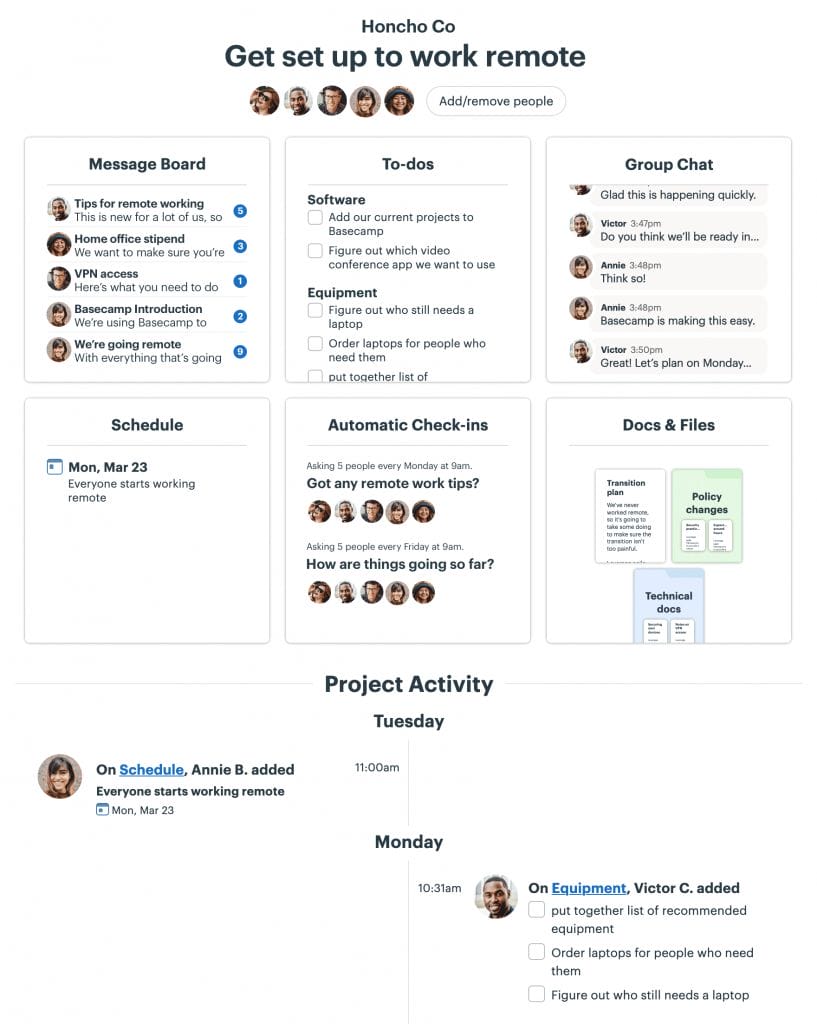
Basecamp is one of the most popular projects management tools in the market. The platform is simple to use and has all the functions that remote teams need for efficient collaboration.
Ideal for small teams, Basecamp can be a limitation for larger teams because the platform still lacks some functionalities such as time tracking.
Why Basecamp for distributed teams?
- Track of projects
- Storage
- You can set due dates for each task/project
- Contains message boards
- Clientside and email forward
Pricing:
Basecamp business: $99/month.
2. Trello
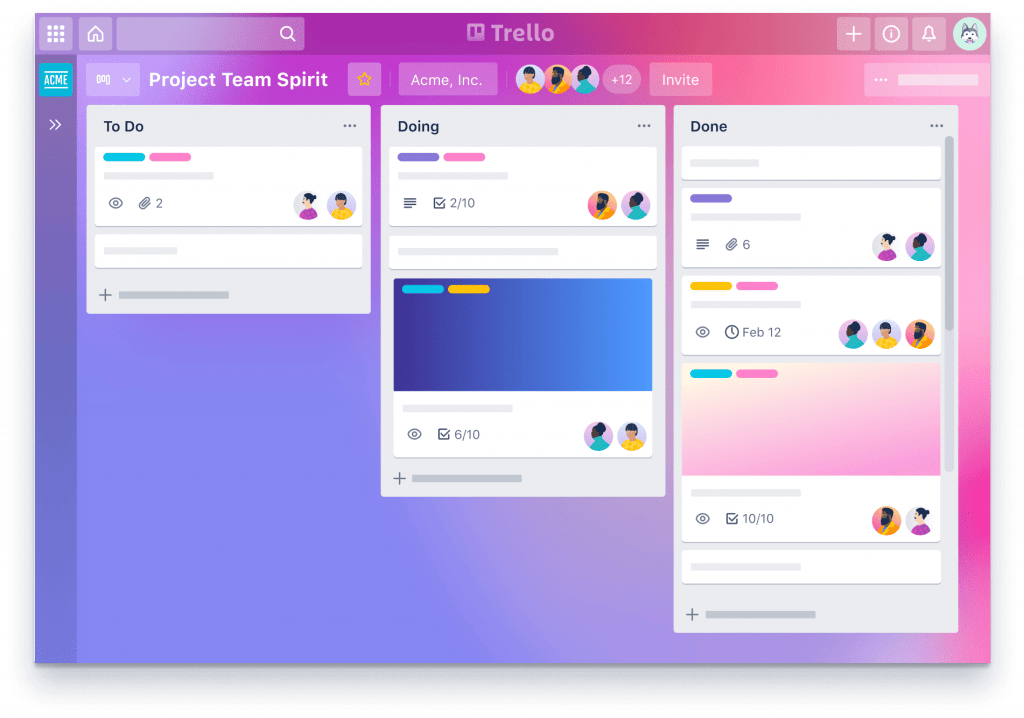
Trello is always on top of the list when looking for virtual collaboration tools. This project management tool was built to help remote teams organize and have everything they need in just one place.
The platform is the digital version of a Kanban board and helps teams organize with a visual representation of the project. It stands out because of its simple system and its different features.
Why Trello for distributed teams?
- Lists and cards to help teams structure their project
- Timeline, map, calendar, and table view
- Drag-and-drop editing
- Easy organization with labeling, comments, and tags
- Progress meter checklist
Pricing:
- Free
- Business Class: $12.50/month
3. Nifty
Nifty is an award-winning project management tool combining communication and collaboration features. So, the software reduces development cycles by combining chat, tasks, project goals, docs, and files in one place. And you can easily manage tasks while your team members focus on productivity.
Why Nifty for distributed teams?
- Features to build roadmaps and break tasks for the team
- Apps and software integration
- Option to track and see other team members’ progress
- Tags for tasks, docs, and files improving scalability within the workspace
- Built-in docs and apps integrations
- Overviews, Workloads, and All Tasks providing automated managerial insights to optimize resources
- Project Discussions and Team Chat allows group and direct communications
Pricing:
- Free (Illimited users, max 2 projects)
- Starter: $39/month
- Pro: $79/month
- Business: $124/month
- Unlimited: $399/month
4. ProofHub
ProofHub is a great collaboration tool to plan, organize, and keep track of a distributed team’s tasks. Ideal for freelancers and businesses of all sizes, the easy-to-use interface doesn’t need download and it’s ready to use.
Why ProofHub for distributed teams?
- Centralized workspace including task lists, workflows, Gantt charts, discussions, calendars, and documents
- Reports on workload to optimize resource
- Selected integration
- Task management features
Pricing:
- Free
- Essential: $50/month
- Ultimate Control: $99/month
5. Clarizen
Clarizen has high reviews online. And it’s one of the project management tools for mid-to enterprise-sized businesses. However, it’s available only for web projects and may lack mobile apps. Without a to-do list and time tracking, it’s better for enterprise-level project managers; IT organizations; and professional services working on web-based project management software.
Why Clarizen for distributed teams?
- Dynamic reports and dashboards
- Portfolio roadmaps
- Goals management
- Slide publisher
- Risk management
Pricing:
Available upon request
6. Asana
Asana is one of the best virtual collaboration tools for IT teams and developers. It is a flexible Saas project management tool allowing automate recurring tasks and supporting custom fields and forms.
Why Asana for distributed teams?
- Recurring Tasks.
- Workload monitoring and management.
- Task display format with archiving capabilities.
- Timeline view.
- Flexible Gantt charts.
Pricing:
- Basic: Free
- Premium: $10.99/month
- Business: $24.99/month
7. Zoho Projects
Source: Zoho Projects
Zoho Projects supports IT businesses to keep track of tasks, bug tracking, and reports. This management tool is more suitable for small and mid-sized teams.
Why Zoho Projects for distributed teams?
- Work breakdown structure
- Issue management
- Universal add
- Different task views
- Gantt chart
- Recurrence
- Reminders
- Critical tasks
- Portfolio dashboard
- Roll-up
Pricing:
- Free (3 users)
- Premium: $5/month
- Enterprise: $10/month
8. Wrike
Wrike is a cloud-based project management tool to improve project planning and collaborate with stakeholders. It’s ideal for facilitating collaboration between different departments, from marketing, software development, and professional services.
Why Zoho Projects for distributed teams?
- Custom request forms
- Interactive Gantt charts
- Kanban Boards
- Purpose-build templates
- Reduce emails and check-ins
Pricing:
- Free (1-5 users)
- Professional: $9.80/month
- Business: $24.80/month
9. Jira
Jira is designed for IT and software development teams. However, the Kanban workflow management system also allows collaboration for remote teams across different departments. And the software includes several features to coordinate tasks and monitor others’ progress.
Why Jira for distributed teams?
- Customizable project workflows
- Unlimited custom fields
- Kanban view
- Customizable dashboards and wallboards
- Reporting and analytics
- API access
- Apps Integrations
- Mobile apps version
Pricing:
- Free
- Standard: $7.50/month
- Premium: $ 14.50/month
10. Microsoft Projects
Microsoft Project is a sophisticated project management platform, including industry-leading features to plan a distributed workflow.
Why Microsoft Project for distributed teams?
- Project budget overview and prediction
- Cloud and on-premise options
- Advanced Gantt charts
- Supports task descriptions
Pricing:
- 1. Project Plan 1: $10.00/user/month
- 3. Project Plan 3: $30.00/user/month
- 5. Project Plan 5: $55.00/user/month
Best Online Video Communication Tools
One of the keys to effective remote collaboration is to talk and see the people you work with, which is only possible with video calls. One of the biggest disadvantages of video calls is wasting time with frozen videos of terrible sounds. And while sometimes it is due to connectivity, other times it’s because of the platform itself.
Here are the best virtual collaboration tools for video calls and hybrid meetings:
11. Zoom
Source: zoom.us
Zoom is the best video collaboration tool for most remote teams. In 2017 the platform reached 700,000 users. And during the pandemic, it became one of the most trending apps globally, with over 300 million participants daily.
Why Zoom for distributed teams?
- HD video, audio, and instant messaging
- Email invitations
- It has rooms and workspaces
- Allows up to 10,000 viewers via Zoom webinars
- Screen sharing and whiteboard options
Pricing:
- Free
- Pro: $149/ year
- Business: $199.90/year
- Zoom united business: $350/year
12. Google Hangouts
Google Hangouts is one of the easiest video conferencing tools to connect with Google contacts and clients outside your network.
Why Google Hangouts for distributed teams?
- Up to 25 video participants
- Video, audio, and messenger conversations
- Video meeting recordings
- Join calls using Google Calendar
- Screen sharing
Pricing:
- 1. Google Meet: Free (100 users)
- 2. Google Workplace essential: $8/month
- 3. Google Workplace enterprise: Customizable
13. Dialpad Meetings
Dialpad Meetings is ideal for small teams with 10 or fewer members. In the basic version, the limit for calls is 45 minutes. However, it allows unlimited video conferences.
Why Dialpad Meetings for distributed teams?
- Up to 10 participants
- Unlimited conferences
- Call recording
- HD Audio
- Screen and document sharing
- Mobile apps integrations
Pricing:
- Standard: $15/month
- Pro: $25/month
14. TrueConf Online
TrueConf is ideal for small teams or individuals collaborating with small groups. In addition, it includes collaboration features like remote desktop control to support clients in solving their problems.
Why TrueConf Online for distributed teams?
- Up to 3 participants on team calls
- HD video
- Multiple collaboration tools like remote desktop control, recorded calls, file transfer
- Virtual whiteboard
- Sharing screen option
Pricing:
- Free version
- Pro: $12.90/month
- Corporate: $300/month
15. Skype
Skype is one of the most popular video tools. It’s ideal for individual calls and small group meetings. In addition, Skype in the Classroom is designed for online education.
Why Skype for distributed teams?
- Up to 10 people on video calls
- HD video
- Screen sharing
- Video call recording
- Interactive video chats
- Location sharing
Pricing:
Costs for Skype depend on the country and the type of business.
16. FreeConference
FreeConference is one of the best video conferencing tools for small teams. First, no download is required. Second, it includes moderator controls features to run meetings and respect timetables.
Why FreeConference for distributed teams?
- Up to 5 online meeting participants
- Screen sharing
- Document sharing
- Moderator controls
- Text chat
Pricing:
- Free (Up to 100 call participants)
- Starter: $9.99/month
- Pro: $29.99/month
Online Collaboration Tools for Communication
Online collaboration tools for working together are crucial to ensure a smooth workflow and avoid overlapping tasks. Surely, video conferencing and meetings are important. But your team members can’t arrange calls for any little issue or question – it would be a waste of time. And that’s why communication and chat tools are necessary addition for distributed teams.
These are examples of collaborative software tools to support your team’s communications and grow your company culture from a distance:
17. Slack
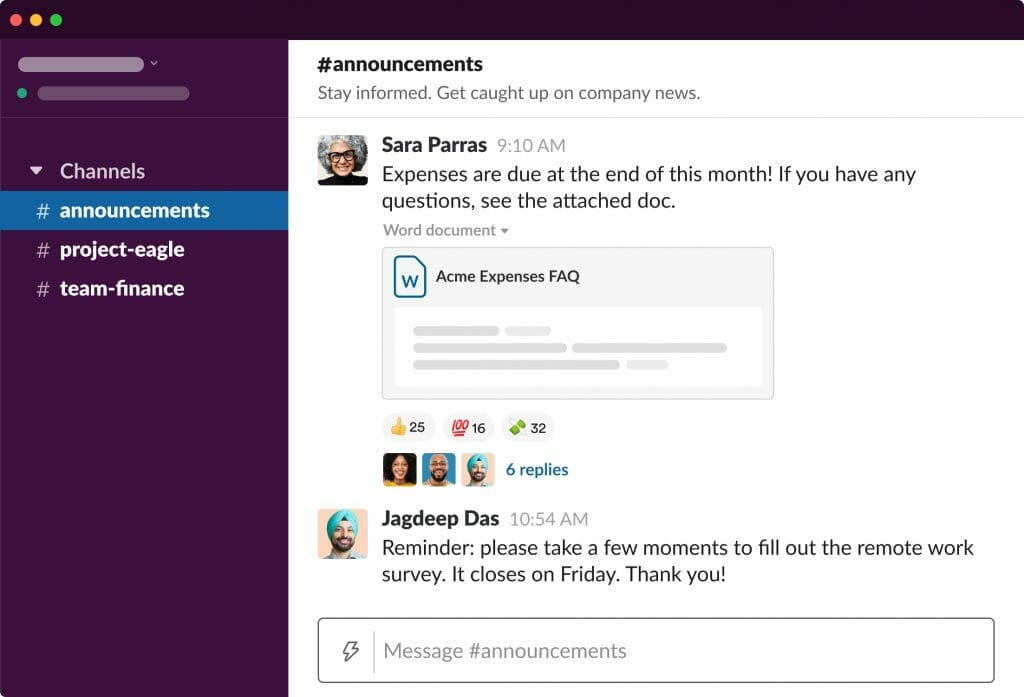
Slack is the instant messaging tool of the moment. In short, it consists of a digital space that helps remote teams communicate and share ideas and comments in real-time. Instead of sending an email, team members get to connect instantly with their coworkers making the communication process faster.
Remote teams can create channels with different purposes, allowing them also to create virtual water coolers.
Why Slack for distributed teams?
- Integrates with other applications such as Google Drive, Twitter, GitHub, Dropbox, Salesforce, and MailChimp, among others
- Easy note-taking
- Custom shortcuts and slash commands
- Automated reminders
- Create different channels
Pricing:
- Free
- Standard: $6.67/month
- Plus: $12.50/month
18. monday.com
Source: monday.com
For hybrid teams, monday.com is one most effective ways to synchronize different tools. From email to Salesforce, or Excel, teams can share information from the office or from home. Finally, this customizable interface automates data entry and sharing documentation, supporting distributed reams’ productivity and workflow.
Why monday.com for distributed teams?
- Pre-designed templates suited to virtual workflows
- Multiple projects “Bird’s eye view” in one convenient location
- Monitor progress from the mobile app
- Calendar mode to keep track of deadlines and meetings
- Check team availability to assign new tasks avoiding overloading
- Automate workflows
- Apps and software integration
Pricing:
- Free Trial (2 accounts)
- Basic: $8/month
- Standard: $10/month
- Pro: $16/month
19. Nectar
Source: Nectar
Nectar is one of the best online collaboration tools for virtual teams in terms of recognition feed and awards. Managers and stakeholders can share their appreciation and feedback to boost the team’s productivity by building an inclusive company culture.
Why Nectar for distributed teams?
- Apps and software integration to improve workflow
- Vast rewards engine including global gift card options or branded company swag
- Customizable interface
- Employee wellness initiatives
- Continued learning courses
- Monthly book challenge
Pricing:
- Free account
- Standard: $2.50/month
- Plus: $3.75/month
20. Bonusly
Source: Bonusly
Bonusly is an online collaboration platform focussing on visibility. It provides an easy interface for managers, executives, and team members. Everybody can see others’ progress and celebrate the team’s achievements.
Why Bonusly for distributed teams?
- Apps and software integration to improve workflow
- Analytics highlighting team members’ strengths
- Watercool features and surveys to collect employees’ feedback
- Easy onboarding setup
- Ideal for companies with 100 employees
- Automated customizable rewards for team member milestones and completed projects
Pricing:
- Free Trial
- Core: $2.70/month
- Pro: $4.50/month
21. Favro
Favro is one of the best examples of communication tools for asynchronous teams working on different time zones. Thanks to the stopwatch-style timer feature, team members can track activities and real-time updates on their browsers.
Why Favro for distributed teams?
- Integration with over 30 project management tools, help desk, and HR apps
- Efficient UI/UX
- Tracking features
- Unlimited screenshots
- Automated timesheets
- Customizable invoices
- Quick team payments
Pricing:
Favro pricing varies depending on account holders, from 2 to +100. Here is the pricing list for 5 team members:
- Lite: $25.5/month
- Standard: $34/month
- Enterprise: $63.75/month
22. Teamwork
Source: teamwork.com
Employees can manage their client work on one platform, from invoicing to time tracking. Teamwork provides several tools and reports to maximize resources and improve tasks planning.
Why Favro for distributed teams?
- Growth-focused features like time tracking, custom client permissions, assigning tasks, etc.
- User-friendly learning curve, including reports and resource management
- Flexible client features to manage multiple projects
- Real-time collaboration features for team members
Pricing:
- Free (max. 5 users)
- Deliver: $10/month
- Grow: $18/month
23. Otter.ai
Source: Otter.ai
Otter is a collaboration app for teams with several integrations with apps like Zoom to facilitate virtual workflow. It automatically transcribes audio into text saving time for your team members and sharing docs wherever your team is located.
Why Otter.ai for distributed teams?
- Several integrations with apps like Zoom
- Features to add live comments, delegate tasks, and action items in real-time
- Zoom participants can add photos, audio, highlighting in real-time to create collaborative meeting notes
- Instant text summary of meetings
Pricing:
- Free for individuals
- Pro: $8.33/month
- Business: $20/month
24. Chanty
Source: Chanty
Chanty includes team chat solutions, collaboration features, unlimited message history, and watercooler features.
Why Chanty for distributed teams?
- Unlimited message history with search options
- Built-in task manager
- User-friendly interface
- Easy setup for onboarding
Pricing:
- Free (max 10 users)
- Business: $3/month
Best Cloud Storage Service Tools
When working in a remote team, communication is everything. But so is documentation. You need to find a safe place to save documents, projects and overall manage all the information your team needs to know.
Whenever someone sends you an email with documents/files, instead of always going back to the email, you can open a shared file and it’s all there. Team members across the world can sync, share and collaborate on documents!
25. Dropbox

Source: dropbox.com
Dropbox is one of the most popular sharing documentation tools. Through the year, it improved security systems and data protection procedures.
Why Dropbox for distributed teams?
- Cloud storage
- Sharing
- Smart sync
- Edit documents online
- Share screenshots easily
Pricing:
- Free
- Plus: $9.99/month
- Family: $16.99/month
26. Drive
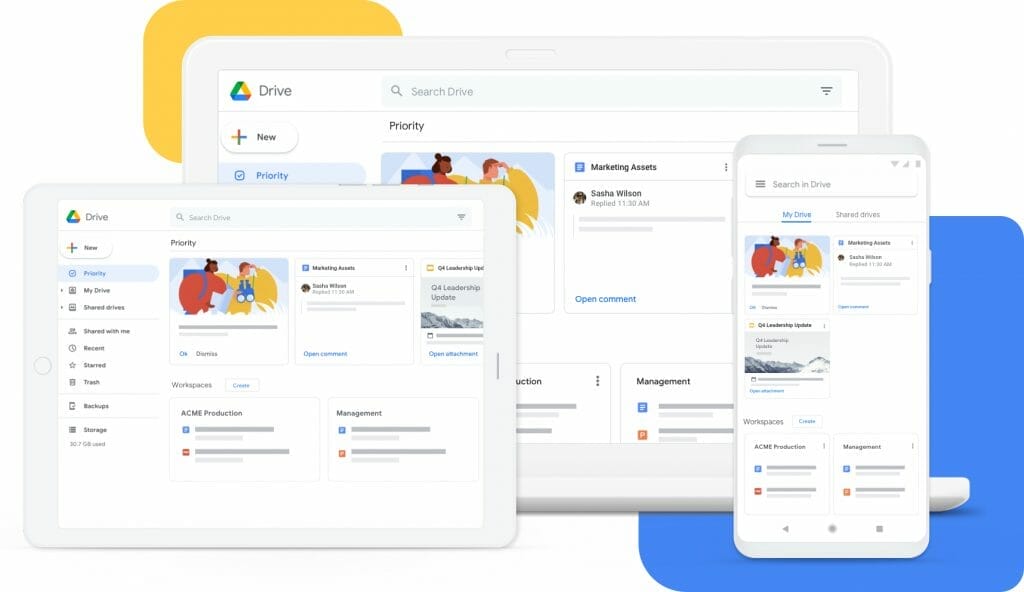
Google Drive is probably the most popular software to share documents. With this cloud service, team members can share documents, create files, edit in real-time, add comments, etc. It’s a key tool that allows remote employees to access files when they can’t reach their colleagues.
Why Drive for distributed teams?
- Easy to use interface
- It’s compatible with Microsoft Office.
- Store files of all shapes and sizes (docs, pds, presentations, etc)
- Access documents anywhere in the world
- Compatible with other apps
Pricing:
- Free
- 100GB: $1.99
- 1T: $9.99
- 10TB+: $99.99
27. Box
Box allows sharing docs with users outside your organization. It includes email invitations and files with expiring dates and passwords to protect links.
Why Box for distributed teams?
- Classification-based security controls and intelligent threat detection
- Document retention
- Disposition policies
- Conduct defensible discovery
- Collaboratuion features
- Apps and software integrations
Pricing:
- Business: $13.50/month
- Business Plus: $22.50/month
- Enterprise: $31.50/month
28. OneDrive for Business
Source: OneDrive
OneDrive is a cloud service powered by Microsoft. You can share doc vis mail or link, accessing numerous security measures to protect data.
Why OneDrive for distributed teams?
- Document scanning
- Online photo storage
- Free online cloud storage
- Personal Vault
- PC folder backup
Pricing:
- OneDrive for Business (Plan 1): $5.00/user/month
- OneDrive for Business (Plan 2): $10.00/user/month
- Microsoft 365 Business Basic: $6.00/user/month
- Microsoft 365 Business Standard: $12.50/user/month
Best Virtual Whiteboards For Virtual Teams
What’s the first word that comes into your mind when you think of collaboration? Whiteboards!
Whiteboards have always been a great method for brainstorming new ideas and coming up with solutions. Collaboration can be trickier in remote teams. But it won’t ever be impossible with the right tools.
And here are the best online whiteboards to get the best out of your remote team:
29. Miro
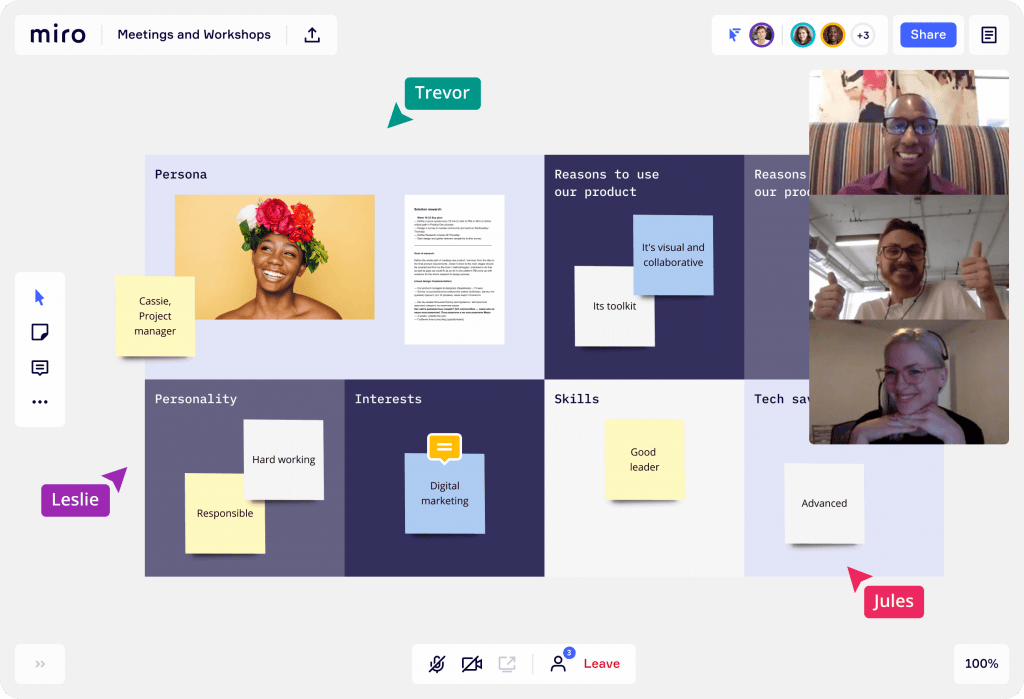
Miro is an online whiteboard hosting several features to connect your team members in real-time. You can select over 50 templates to improve your team’s workflow.
Why Miro for distributed teams?
- Post-it notes
- Online drawing options
- Simple navigation
- Messaging
- Real-time commenting options
Pricing:
- Free
- Team plan: $8/month per user
- Business solution: $16/month per user
30. Mural
Source: Mural
Since 2011, Mural has been one of the most popular online collaboration tools to brainstorm, transforming ideas into chats, flowcharts, and more.
Why Mural for distributed teams?
- Multiple board layout options (Mind maps, flowcharts, sticky notes, storyboards, etc)
- File storage
- Searchable boards
- Unlimited workspaces
- Multi-user editing capabilities
- Video, audio and chat messaging
- Team member activity analytics
Pricing:
- Start Plan: $12/user/month
- Plus Plan: $20/month
31. Whiteboard Fox

If you aim to encourage teamwork, Whiteboard Fox is one of the best free collaboration tools for remote teams. While other online whiteboards have many exciting features, whiteboard Fox is simple, and it goes straight to the point: whiteboarding.
It has a blank canvas where you and your team can start working and drawing right away.
Why WhiteBorad Fox for distributed teams?
- Easy to use
- Allows real-time collaboration with your team
- Zoom in/out
- Freehand drawing
- Ruler tool
Pricing:
100% Free!
Boost Your Virtual Team’s Collaboration With The Virtual Tools!
Remote work is the norm! You can’t escape it – although honestly, who would’ve wanted to escape it?
Despite its benefits, we can’t ignore that managing remote teams is challenging, and we need the right tools to succeed. These virtual collaboration tools have proven to help remote teams thrive and increase their productivity and engagement.
What are you waiting for if you haven’t tried them up yet?






